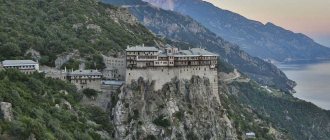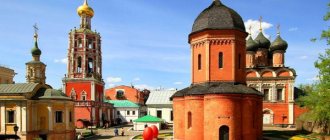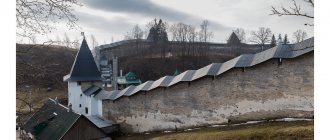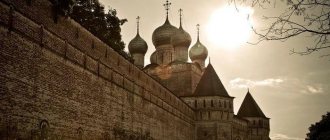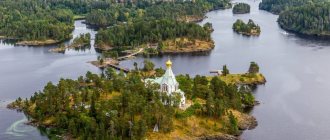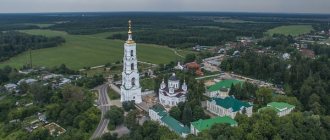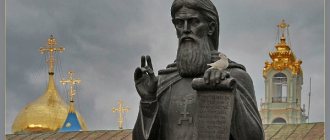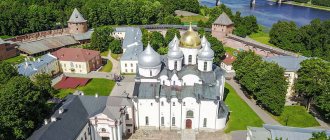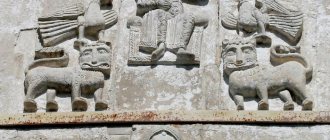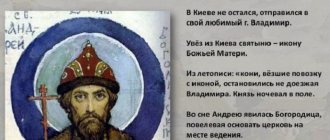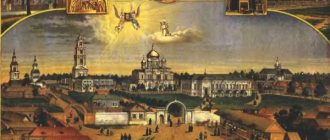How to get there?
From Perm we take the Perm-Ekaterinburg highway and drive 72 km to the right turnoff to Kalinino (57.503587, 56.652579) - it will be immediately after the left turnoff to Kylasovo. Afterwards we drive along the main road without turning anywhere for another 46 km (Troelga, Ershi, Bym, Kalinino, Kordon).
Belogorsky St. Nicholas Monastery
Address:
Perm region, Kungur district, village.
Belaya Gora, st. Monastyrskaya, 1 Phones:
+7 (34271) 5-75-35
Email: Official website:
uralafon.rf
Coordinates for GPS navigator
57.392208, 56.230288
Belogorsky Monastery on the map
White Mountain is an extraordinary place
The monastery received its name in honor of Mount Belaya, so named because snow that does not melt for a long time covers the peak with a white cap until the summer. And in winter it is white and white from the kitchen: shaggy frost abundantly and intricately covers the branches of the trees.
White Mountain is beautiful. When you stand at the top, you see an ocean of forest under your feet, stretching for 100 kilometers. In the vast expanse, everything vain and petty dissolves without a trace, doubts and worries leave.
The mountain is called a place of power. Here are underground springs of small rivers and healing springs. Groundwater rarely rises to higher elevations, and the White Mountain is saturated with springs: 13 streams flowing from the slopes turn into rivers.
From the top comes a spring, consecrated in the name of St. Nicholas the Wonderworker . A wooden staircase leads to the holy spring, and nearby there is a chopped chapel-font. Healing water is collected in a tiny chamber.
At the top there are wooden pagan temples, under the slopes there are secret grottoes. Escaped convicts hid here, wanting to live quietly and freely. The Belogorsky Monastery was founded here.
They say that the mountain does not allow everyone. On the way to Belogorye, cars and buses often break down, and the weather often deteriorates sharply on the road, but if you are allowed into the Belogorsk Territory, the impression will be unforgettable.
Read also
4 best weekend routes around the Urals in winter
The Urals are undoubtedly a treasure trove of amazing nature and unique sights. You can travel around our region in summer, winter, and autumn, … Read more
Silence of the White Mountain
Grandiose plans for epic trips during the New Year holidays went down the drain - members of the household (including me) showed weak immune systems and came down with snot... Find out more
Where to go for the long weekend on March 8?
Of course, this weekend is not that long if you compare it with the New Year holidays... But still, in my opinion,... Find out more
Belogorsky Monastery - a place of salvation and prayer
White Mountain has long been considered a place of salvation and prayer. Since the 18th century, fugitives from factories and Old Believers, persecuted by the authorities, hid here in cells and monasteries. In 1891, a cross was erected on the mountain in memory of the miraculous rescue of Tsarevich Nicholas, the future Russian emperor, from an assassination attempt in Japan. The cross, more than 10 meters high, was popularly called the Tsar’s cross.
The Orthodox Church had a project - to create a monastery on an elevated place, which was founded in June 1893. By the end of the winter of 1894, the first wooden church, rectory and fraternal buildings were built, and a school for orphan boys was opened. From then on, the brethren of the Belogorsk monastery treated the royal family with respect.
Monastic life
The monastery grew quickly. The first abbot of the monastery, Father Varlaam , was an extraordinary man. Coming from a family of Old Believers, he converted to Orthodoxy and began to work zealously in the field of the Lord.
The monks were engaged in arable farming, had 9 cows, raised fish in 9 ponds, kept bees, owning 580 acres of land. A bakery, icon-painting and craft workshops were organized at the monastery.
On September 16, 1897, 5 holy icons were brought from the capital in a religious procession, but the monastery was overtaken by trouble. 3 years after construction, the wooden temple burned down.
Missionary calling of the monastery
The monastery, headed by Father Varlaam, shone with holiness: from the first days such strict rules were observed here that the monastery was nicknamed the Ural Athos , entrusted with a special mission - to be an educator among schismatics. Following their missionary calling, the monks conducted tireless conversations with schismatics and managed to convert many. Over the first decade, the number of inhabitants grew from 12 to 400 people.
The strict ascetic life bore fruit: the young Belogorsk monastery became famous for its eldership. Thousands of pilgrims rushed here for spiritual nourishment.
In April 1901, a terrible storm raged on White Mountain, the wind damaged the monastery buildings and toppled the Royal Cross. Therefore, in June 1902, the Cathedral of the Exaltation of the Cross . The cross on the mountain was restored, the merchant Pavel Stepanovich Zhirnov donated money, and in September 1901 the new cross shone as before.
Holy Cross Cathedral – the pinnacle of the monastery’s spiritual flourishing
The temple, built in the Byzantine style, took 15 years to build with the whole world; it could accommodate 8 thousand people at a time. The building materials were produced by the monks themselves at the monastery brick factory.
The grandiose seven-domed Church of the Exaltation of the Cross, the 7th largest in Russia, stands on the top of Mount Belaya at an altitude of 446 meters. The cathedral, visible from many kilometers away, seems to float in the sky.
The solemn ceremony of consecration of the majestic temple, held in July 1917, lasted three days: the cathedral could not simultaneously accommodate everyone who wanted to attend the service.
The temple was equipped with steam heating and ventilation. An underground passage was built between the fraternal building and the cathedral.
The floor was laid with Metlakh tiles, and asphalt was laid on the pre-cathedral square. Expensive icons were placed in the iconostasis - 3,000 rubles each - an unthinkable amount at that time. The Kungur merchant Shinshin donated gilded crosses for the cathedral.
During the First World War, the Belogorsk Monastery donated 500 rubles in gold coins on March 6, 1916 to the needs of the Russian army.
Shrines
The main shrine of the monastery is the miraculous icon “Mary found grace from God,” which has miraculously survived to this day. What is known about it is that Maria Shestyukova brought it with her from the Kiev Pechersk Lavra. The icon, which had been in the dungeon for a long time, did not turn black or lose its bright colors. She helps everyone who turns to her for help and support.
The icon of the Mother of God “Seven Arrows” remained at the holy spring near the monastery until 1943. Then it was lost. The copy of this rare icon is now kept in the monastery.
The monastery was always grateful to people who, with donations or their labor, helped the brethren build the monastery. Their special gratitude goes to the believers participating in the revival of the monastery. A copy of the “Divnogorsk-Sicily” image of the Mother of God is a valuable gift from benefactors.
The monastery also houses reliquaries with holy relics:
- Prince Alexander Nevsky;
- Martyr Peter of Voronezh;
- St. Anne's;
- St. Luke of Simferopol;
- Spyridon of Trimifutsky.
Temple
In the temple they lit candles for the repose of the deceased relatives, St. Nicholas the Wonderworker. It was not possible to consecrate the cross this time. The clergy were busy with the service, then the excursion began.
We left the temple to take a walk around the area. It was incredibly hot outside, over 35 degrees. But it was fresh, the air was crystal clear.
After photographing all the local attractions, we set off on foot to Kalinino. We bought tickets. There were several hours left before the bus departed.
We decided to take advantage of the moment and sunbathe. Overall we enjoyed our little self-guided tour. If you have never been to these places, we recommend that you definitely visit the Belogorsky Monastery.
There were a lot of photographs. Within the framework of the article, we post only the most successful ones in our opinion).
Where to stay
The Belogorsky Monastery (Belogorye, Voronezh region) is located in a secluded place. The monastery buildings are in an unsuitable condition for habitation; a few brethren and workers are still huddled on the farm. It is impossible to stay in the immediate vicinity of the caves. However, in the warm season, the brethren organize food for pilgrims on their territory in a summer, open refectory.
Independent travelers arriving in Belogorye are advised to contact the local Trinity Church, where they will be told the most convenient way to the caves at this time of year.
Pilgrims and tourists can stay in the city of Pavlovsk, which offers hotels, guest houses and hostels with accommodation costs from 500 to 3,500 rubles. However, given the need to travel across the Don to the other side of the river, which lengthens the path to the monastery, it is advisable to consider choosing a hotel on the M4 Don highway closer to the crossing.
Noah Motel
The mini-hotel is located on the 661st km of the M4 highway, in the village of Aleksandrovka Donskaya. Guests with pets are welcome here, providing accommodation in 2-4-bed rooms. All 14 rooms are equipped with the necessary furniture, household appliances, and have their own bathrooms with showers.
The motel features a restaurant, bar and laundry services, as well as free parking and Wi-Fi. Cost of living – from 800 rubles.
Hotel "Rodnichok"
A new, small hotel, which opened in mid-2020, is located in the village of Zaoserednye Sady (668th km of the M4 highway). All rooms are air conditioned and have flat-screen TVs. Private bathrooms are equipped with modern fixtures, towels and hygiene products.
The hotel has a mini-market, a restaurant with a bar, a relaxation area in the garden, and parking for cars. The reception is open 24 hours a day and guests are advised that there is no internet access. Cost of living – from 1000 to 2500 rubles.
Guest house "Kak Doma Guest House"
Guest house located at: Zaoserednye Sady, st. Pervomayskaya, 1a, offers rooms for 1-4 people. Breakfast, free parking and Wi-Fi are included in the room rate. The rooms of different categories have modern furnishings, are equipped with electric kettles and coffee makers, and are equipped with TV broadcasting. Budget rooms include use of a public bathroom. Cost of living – from 700 to 2700 rubles.
The Belogorsky Monastery near the village of Belogorye is once again becoming a famous landmark of the Voronezh region. An increasing number of tourists who want to walk through the underground passages, touch history and be amazed at the perseverance and determination of their ancestors come to these places. Many people prefer to get to the monastery along the Don, and then climb to the very top to the entrance to the dungeon, from where a stunningly beautiful view of the river valley opens.
Revival of the monastery
The revival of the monastery began in 1988, when the 1000th anniversary of the Baptism of Rus' was celebrated. On January 29, 1991, the Holy Synod blessed the opening of the St. Nicholas Monastery , where monastic life was resumed.
Pilgrims and philanthropists flocked to White Mountain. In 1992, the monastery prepared 25 tons of galvanized iron and 3 tons of iron for staples, as well as 1.5 tons of nails, timber and paint.
In 1993, a restoration project for the Belogorsk Monastery was developed. In January 1995, construction of a road began to reach Belaya Gora. Since July 22, 1997, religious processions have been held annually from the city of Perm to the White Mountain.
On July 2, 1998, a solemn ceremony of canonization of the Venerable Martyr Varlaam of Belogorsk and the murdered brethren of the monastery took place on Belaya Mountain. Memorial Day – August 12.
Starting in 1999, the temple was rebuilt over 10 years, spending 200 million rubles. The cathedral has been restored, the refectory, monastic buildings and guest rooms are being repaired. On September 27, 1998, the historical Royal Cross made of stainless steel was erected in the Belogorsk Monastery at the expense of benefactors. Every year the Belogorsky Monastery becomes more elegant and beautiful.
In 2011, the website of the Belogorsk Monastery “Ural Athos” was created, and the newspaper “Voice of Duty” . The missionary service of the monastery implements the “Grateful Memory” project. At the entrance to the upper church of the Cathedral of the Exaltation of the Cross there is a wall lined with ceramic tiles with the names of people and organizations helping to revive the Belogorsk monastery.
The names of all benefactors, regardless of the amount of the contribution, are entered in the Book of Thanksgiving of the temple and in the Chronicle of Good Deeds. The number of philanthropists is growing. Conferences and seminars on religious topics are held with the participation of clergy and authorities, cultural figures, scientists and the public.
Temples of the Belogorsk Monastery:
- Cathedral of the Exaltation of the Holy Cross.
- Church of Spyridon of Trimifuntsky.
- Chapel of St. Nicholas the Wonderworker at the source.
- Chapel-font by the pond.
- Chapel "Seeking the Lost" icon of the Mother of God.
- The courtyard of the Belogorsky Monastery is the Church of the Nativity of the Blessed Virgin Mary.
Shrines:
- The miraculous icon of the Iveron Mother of God, painted by the monks of the holy Mount Athos.
- The Ark of the Holy Saints, brought from Jerusalem.
Patronal holidays:
- Nicholas the Wonderworker, Saint, Archbishop of Myra - May 22 and December 19.
- Icons of the Most Holy Theotokos of Iverskaya - October 26, February 25 and May 6.
Holy Cross Cathedral
The Exaltation of the Cross Cathedral was built in the neo-Byzantine style, modeled on the Vladimir Cathedral in Kyiv. From the very beginning, the temple was equipped with ventilation and steam heating.
The monumental cathedral, the most grandiose in the Perm diocese, was built both with donations from private individuals and at the expense of the monastery itself; according to the monastery’s reports for 1909, the monastery was engaged in arable farming, cattle breeding, beekeeping and fishing, the monastery owned 580 acres of land, had 40 cows and 9 ponds.
Literature
- Timofeev Ya. Belogorsk caves. Voronezh, 1869.
- Krehovetsky, Nikolai, Belogorsk Caves
, 1878. - Ostrogozhsky Resurrection Belogorsky Monastery // Memorable book with the address-calendar of the Voronezh province. for 1887. Voronezh, 1887. P. 313-315.
- Weinberg L. B. Essay on the most remarkable antiquities of the Voronezh province. Voronezh, 1891. pp. 53-54.
- Markov E.L. Belogorsk caves // RV. 1892. T. 1. P. 265-277.
- Peter, abbot. Cave digger Maria. Pavlovsk, 1897.
- Tevyashov V.N. Cave monasteries of the Ostrogozhsky district. // Tr. Voronezh scientist arch. commission Voronezh, 1907.
- Nikolsky P.V. Monasticism on the Don: Cave Digging in the 19th Century. // Voronezh antiquity. Voronezh, 1910. Issue. 9. pp. 156-181.
- Pluzhnikov V.I. Cave monasteries on the Don and Oskol // Monuments of Russian architecture and monumental art: Cities, ensembles, architects. M., 1985. pp. 109-113.
- Kalashnikov T.V. History of the village of Belogorye. [B. m.], 1966. RKP. pp. 21-31.
- Cave temples of the Don region. Voronezh, 1999; Stepkin V. Belogorsky Resurrection Monastery // Voronezh Diocese. Vestn. 2000. No. 1-2 (66-67). pp. 47-51.
- Shevchenko E. Voronezh Jerusalem // Voronezh Courier. 2000. 5 Dec.
Terrible times in the life of the monastery
The rich monastery with its grandiose cathedral attracted the attention of the communists. Having captured it, they desecrated the throne and took out the ark with the relics, destroyed the library and plundered property, and in the place of the Royal Cross they erected a monument to Lenin.
The Red Terror in Belogorye was characterized by unprecedented cruelty. On August 12, 1918, the Bolsheviks, having cruelly tortured Bishop Varlaam, drowned him in the Kama River, stuffing him into a sack. 36 monks were shot on the spot, thrown into a pit and filled with sewage. 102 Belogorsk inhabitants were taken to forced labor, where they died or went missing. In March 1923, the monastery was closed.
Since 1930, in the monastery buildings on Belaya Gora there has been a camp for repressed and special settlers, and later a Home for the Disabled. In 1941-45, on White Mountain - a rehabilitation center for wounded and disabled people of the Great Patriotic War, disabled people from labor and childhood. In 1980, a fire broke out in the Belogorsk Monastery, destroying the domes of the temples.
